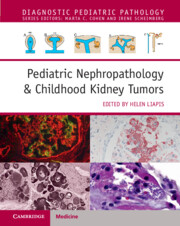Book contents
- Pediatric Nephropathology & Childhood Kidney Tumors
- Diagnostic Pediatric Pathology
- Pediatric Nephropathology & Childhood Kidney Tumors
- Copyright page
- Dedication
- Contents
- Contributors
- Preface
- Section 1 Normal and Abnormal Human Kidney Development
- Section 2 Glomerular Diseases
- Section 3 Tubulointerstitial Diseases
- Section 4 Vascular Diseases
- Section 5 Infectious Diseases
- Section 6 Cystic Diseases
- Chapter 13 Autosomal Dominant Polycystic Kidney Disease and Autosomal Recessive Polycystic Kidney Disease
- Chapter 14 Tuberous Sclerosis Complex
- Chapter 15 Glomerulocystic Kidney (GCK) and GCK Disease (GCKD)
- Chapter 16 Nephronophthisis Complex
- Section 7 Solid Tumors of the Kidney
- Section 8 Transplant Pathology of the Kidney
- Index
- References
Chapter 13 - Autosomal Dominant Polycystic Kidney Disease and Autosomal Recessive Polycystic Kidney Disease
from Section 6 - Cystic Diseases
Published online by Cambridge University Press: 10 August 2023
- Pediatric Nephropathology & Childhood Kidney Tumors
- Diagnostic Pediatric Pathology
- Pediatric Nephropathology & Childhood Kidney Tumors
- Copyright page
- Dedication
- Contents
- Contributors
- Preface
- Section 1 Normal and Abnormal Human Kidney Development
- Section 2 Glomerular Diseases
- Section 3 Tubulointerstitial Diseases
- Section 4 Vascular Diseases
- Section 5 Infectious Diseases
- Section 6 Cystic Diseases
- Chapter 13 Autosomal Dominant Polycystic Kidney Disease and Autosomal Recessive Polycystic Kidney Disease
- Chapter 14 Tuberous Sclerosis Complex
- Chapter 15 Glomerulocystic Kidney (GCK) and GCK Disease (GCKD)
- Chapter 16 Nephronophthisis Complex
- Section 7 Solid Tumors of the Kidney
- Section 8 Transplant Pathology of the Kidney
- Index
- References
Summary
Cystic kidney disease is defined broadly by ectasia or dilation of hollow epithelial-lined nephrons and collecting ducts spanning from Bowman’s capsules to the ducts of Bellini. The number of cysts per kidney can range from single (isolated) to innumerous. The distribution of cysts may be focal or diffuse, having widespread organ involvement. Cystogenesis requires two stages: cyst initiation (the triggering event) and cyst expansion (maturation). When this occurs early in life, cysts are considered congenital. They may be sporadically acquired or transmitted in an autosomal dominant (AD) or autosomal recessive (AR) pattern. Historically, congenital and inherited cysts were considered to have disparate etiologies, but gene defects have been recently implicated in the formation of congenital cysts. Cysts may be syndromic (concurrently involving other organ systems in consistent patterns) or non-syndromic. While isolated renal cysts are often asymptomatic, most inherited polycystic cystic diseases (PKD), including ADPKD and ARPKD, symptomatically affect both kidneys (bilateral). In this chapter we focus on ADPKD and ARPKD in children. CAKUT is discussed in Chapter 1, tuberous sclerosis in Chapter 14 and glomerulocystic kidney disease in Chapter 15.
- Type
- Chapter
- Information
- Pediatric Nephropathology & Childhood Kidney Tumors , pp. 255 - 271Publisher: Cambridge University PressPrint publication year: 2023



